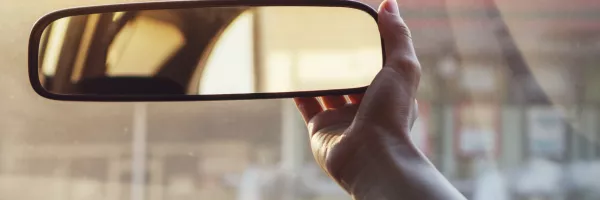
The phrase “blind spot” is enough to terrify any new driver, which is why we've decided to help you avoid this problem by telling you the right way to adjust your mirrors. For some reason, this technique is rarely taught to new drivers and they end up adjusting their mirrors improperly, just like everyone else.
What, This Is Possible?
Absolutely! People have been setting their mirrors wrong for decades, placing significant portions of their vehicles in the mirror for no good reason. As a result, people rarely use these mirrors and have learned to either rely on their inside mirrors or to physically turn their heads to check blind spots. According to the National Safety Council, proper mirror adjustment is essential to avoid collisions.
While the latter method is still the safest, there's no reason you need to buy “blind spot mirrors” to eliminate these dangerous areas. All you need to do is adjust your interior mirror and your two side mirrors properly and the size of your car's blind spot will shrink to practically nothing. This will help new drivers like you avoid silly accidents.
How Do I Adjust The Inside Mirror?
The inside mirror isn't just for making faces at your friends in the backseat (in fact, stop doing that!). It is designed to give you a view of what is directly behind you. Obviously, it doesn't give you a full view, but that's why you use your side mirrors. However, you still need to adjust your inside mirror properly.
Start by sitting inside the car in the posture you typically use when driving. Now, look up into the mirror and adjust it with your hand until you can see out the back window in a complete and level fashion. This simple adjustment should take no more than a few seconds. The AAA Exchange provides a detailed guide on mirror adjustments.
What About The Side Mirrors?
The truth is, most drivers are doing just fine with adjusting their inside mirrors. It's still worth knowing how to adjust it, but you probably would have done it right anyway. That said, you and probably everyone you know are adjusting your side mirrors wrong.
For the passenger side window, you need to sit in your seat and look in the mirror. Adjust it until you can no longer see the side of your car. You need to do this at the threshold of being able to see the car, moving it just one step beyond that point. Adjust its height until it is parallel to the ground. Repeat the process with your driver's side window.
Now, when you are driving, you can check each mirror to get a great view of the lanes to your left and right. By also assessing the situation with your inside mirror, you can get a complete and unparalleled look around your car without turning your head. The Car and Driver magazine also offers an excellent resource for mirror adjustment techniques.
Does That Mean I Shouldn't Check For Blind Spots Anymore?
Not quite: all it means is that you greatly reduce your danger of accidentally running into someone when changing lanes. Relying entirely on your rearview mirrors to check blind spots isn't a good idea because it takes control out of your exact perception and relies entirely on reflected perception.
Even if your mirrors are accurately positioned, they may not be giving you a 100% accurate position of the vehicles around you. In tight driving situations, precise positioning is crucial when changing lanes. So while you can rely on your mirrors when there are few cars on the road or they are far behind you, make sure to visually check the vehicle's position in your blind spot if another vehicle is much closer.
By following these simple tips, you are helping yourself become a safer and more confident driver. You will avoid problematic accidents and help promote a safer driving environment around you. For more driving tips and resources, visit the National Highway Traffic Safety Administration website.